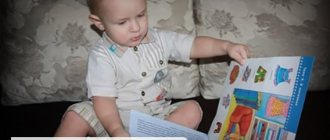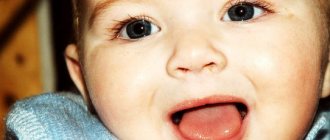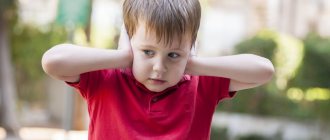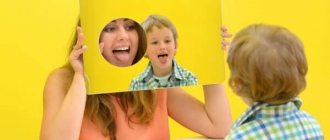One of the necessary conditions for the normal development of a child is speech therapy classes. They can be carried out either with parents or with a specialist - a speech therapist. There are simple ways to find out if your child needs professional help. Correct speech is formed in childhood, so you should not ignore signs of development of defects.
When to see a speech therapist: signs of speech impairment
Speech problems will not go away on their own unless you work on them. Speech therapy classes for children are necessary:
- if the child does not pronounce simple sounds, speech is unclear, words are swallowed;
- replaces one sound with another;
- knows few words regarding the norm for his age;
- at 2-3 years old, many “own” words are used and few correct ones;
- the child understands everything, but for some reason does not want to speak;
- if after 4-5 years the soft pronunciation remains: “kisya”, “pil” instead of “pil”, etc.
- if there is hesitation, stuttering, repetition, especially frequent repetition;
- if you have problems with memorization and retelling;
- in words, letters and syllables change places;
- at 5-5.5 years old the child does not pronounce “r” or pronounces it in the French manner;
- By the age of 7, problems with writing are noticeable.
Advice: If a child does not say “r” at all, it is usually easier to introduce the sound than to relearn it from “French”. In the second case, you often have to contact a specialist.
The most common violations that require professional help:
- Dyslalia is the incorrect pronunciation of sounds in children 4-5 years old. At the same time, words are used in the correct genders, numbers and cases, the vocabulary is age appropriate, phrases and sentences are constructed correctly.
- General speech underdevelopment. Signs: difficulties in word formation, small vocabulary for one’s age, problems with pronunciation.
- Disturbances in the tempo and rhythm of speech—acceleration or slowdown in the pronunciation of words and sentences.
When should I take my child to a speech therapist?
I don’t even know why, but today the number of children with problems with sound pronunciation has increased sharply. Tell me, how much time a day do you devote to reading, and how much to watching TV together? One of the reasons I see is the global interest of children (almost from the cradle) in technical means. The children communicate little. There is no desire for this. What for? After all, there are so many interesting things around, and they are concentrated in one place: on TV.
As a result, we ourselves may miss that golden moment to send our child to a specialist. Speech therapists have an unspoken rule: the sooner, the better. That's right, this should be resolved immediately. Sorry for the comparison, but if you stain a dress and leave it for a long time without washing, what will happen? Of course, there is a risk that the stain will set in and not wash off. So it is here.
Speech therapy classes for children - we do them at home.
The peak of visits occurs for children 4 - 5 years old. Right now they must pronounce complex consonants and construct sentences with logic. More precisely, even texts involving elementary words. There must be consistency in his stories. Do a test by asking your child to retell a simple picture. Did not work out? Then see a specialist!
When an accurate diagnosis is made, you will begin to attend classes that are sure to give results. But don’t be lazy at home either, practice in a playful way, at least for 20 minutes. Just don’t force it, kids don’t like it! And I’ll tell you what exercises you can do at home, depending on the problem.
At what age is preventive consultation with a speech therapist recommended?
Children master speech gradually, and each age has its own standards. Of course, some deviations are possible, but a significant difference from general developmental indicators is a reason to contact a speech therapist. Standards for pronunciation and understanding of sounds, words and phrases:
- By the age of 1 year, simple words and gestures should be distinguished, 3-4 words should be pronounced.
- By the age of 2, the vocabulary expands to 50 words, children speak in simple structures of 2-3 words. A two-year-old child must correctly pronounce the sounds b, m, f, v, t, d, n, k, g.
- At 2.5 years, elementary phrasal speech is formed.
- At 3 years old, children begin to use case forms, singular and plural numbers, simple prepositions, and conjunctions.
- By the age of 4, a child should be able to pronounce hissing and whistling sounds.
- The most complex sounds l and r are mastered by 5-5.5 years. By this age, all parts of speech are already used, all sounds are pronounced clearly, do not change places in words (except for complex and new words, for example, “tortuar”, some “incorrect” words remain from earlier childhood, were memorized incorrectly and are pronounced by the usual old Thus, you need to be patient in relearning).
From the moment the baby’s speech is formed, you can begin classes with a speech therapist. Serious deviations will be revealed by 2-3 years, in which case there is no need to wait 5 years. If articulation disorders are minor (for example, a child does not say “r” at 4.5 years old), it is better to focus on articulatory gymnastics - all the basic exercises will be suggested to you by the teacher in kindergarten, where speaking classes are mandatory. If you do not take your child to kindergarten and notice some delay or abnormal development of articulation, contact a speech therapist for preventive consultation.
A baby who was born as a result of a problematic pregnancy and was observed by a neurologist especially needs consultation with a speech therapist.
Summary of an individual lesson at a speech center for children of the senior group
Explanatory note The lesson is intended for speech therapists working at a speech center. For practicing - articulation exercises (switching from one articulation pattern to another); - correct speech breathing; - distinguish between whistling and hissing sounds; - introduction of delivered sounds into speech. Differentiation of sounds (S-SH) “Snake and funny tigers”
Purpose of the lesson: To practice articulation exercises necessary for producing disturbed sounds; to consolidate the pronunciation of whistling sounds;
clarify the articulatory structure of hissing and whistling sounds; automation of the sound “Ш” in syllables, words, sentences. Differentiation of whistling-hissing sounds. Development of phonemic hearing. Practicing proper breathing. Clarify and expand your vocabulary on the topic “Animals”. Develop attention, memory, logical thinking. Develop fine motor skills of the hands. Develop communication skills. Cultivate a love for living nature and a desire to protect it. Material: Toys (snake, tiger cubs, hedgehog, owl), forest, magic box, puzzles, balloons, etc. mirrors, napkins, treats, TSO. There is a magic box on the table. And to find out what is in it you need to solve riddles. 1. He is huge and mustachioed and also striped. If you meet someone who is not in the mood for games Because this is ..../ Tiger/ 2. A rope is crawling along the ground Here is the tongue, open mouth, Here is the tongue, open mouth, I am ready to bite everyone, Because I am ...../Snake/ Task: assemble the puzzles / cut-out pictures/ and see if you guessed the riddles correctly. - Now listen, this is the story that happened to our animals. Once upon a time there lived a snake in the forest. One day she decided to take a walk and crawled along the path. Suddenly, tiger cubs came out from behind a bush. “R-R-R” the tiger cub growled. The snake got scared and decided to hiss. “S-S-S” she said; she failed to scare the tiger cubs. The snake burst into tears. A hedgehog ran past, heard the “conversation” of the animals and decided to help the snake. Do you guys pronounce the “Sh” sound correctly? Hedgehog: -I will teach you and the guys how to pronounce the sound “SH” correctly. To do this, we will first do breathing exercises, then articulation exercises for the lips and tongue.
-Today we will learn to breathe correctly. I'll tell you a little secret: you have a ball in your stomach. When you inhale air, the balloon inflates, when you exhale, the balloon deflates. Now look at me and listen to my commands. Inhale through your nose and the balloon inflates. Hold your breath. Exhale through your mouth - the balloon is deflated. Wait a little, don't exhale! Wonderful! Now let's repeat the same thing on the count of three: Inhale - one, two, three. Let's repeat the same thing again on the count of three: Inhale - one, two, three. Hold your breath - one, two, three. Exhale - one, two, three. Well done!
Gymnastics for the tongue and lips. Articulation exercises. "Cup"; "Painter"; "Swing"; "The Elephant Drinks"; "Smile" ; "Chupa Chups"
“Owl” lives in the forest and she invites us to play. Physical exercise: Auntie is an owl with a big head. He sits like a bitch and looks at everyone. And when suddenly it flies, it rustles with its wings: shhhhh.
The articulatory pattern of whistling sounds:
lips in a smile, a wide tongue stretches down behind the lower teeth, blowing down, the air stream is cold.
The articulatory structure of hissing sounds:
lips are round, the wide tongue is raised up by the upper teeth, we blow upward, the air stream is warm.
Low mobility game “Blow up the bubble but don’t burst” Game “Repeat the syllables in pairs” sa - sha sha - sasha - sa - sha so - sho sho - so sho - so - sho su - shu shu - sus shu - su - shu sy – shi shi – sy shi – sy – shi Game “Repeat the words in pairs” mustache – ears bear – bowl roof – rat us – our Game “Speak clearly” shepherd six highway drying Game “Speak clearly phrases” Big dog Fluffy cat Task: Name baby animals, find and name the mother of the babies and draw a line from the baby to the mother. Game “Find Your Mother” Our tiger cubs have a mother…. She is looking for tiger cubs. It's time for them to go home. The cubs and the snake became friends and decided to play together. The snake sang its “correct” song. /Listening to a recording of a song about a snake/ The hedgehog praises the children and treats them to lollipops. Wishes children to learn to speak correctly.
We recommend watching:
Summary of an individual educational activity with a 5-6-year-old pupil for the correction of sound pronunciation. Notes of an educational activity in a senior speech therapy group. Notes of a lesson in a senior speech therapy group. Notes of an individual correctional and developmental speech therapy lesson. Senior group
Similar articles:
Summary of educational activities in the older group of children with severe speech impairments on the topic: “Sounds S - Z”
Summary of educational activities in the senior group of children with severe speech impairments on the topic: “Sounds S - Sh”
Summary of a subgroup GCD to eliminate disturbances in sound pronunciation in children of the older group with severe speech impairments
Summary of educational activities in the senior speech therapy group on the topic “Cossacks and their traditions”
Logorhythmic lesson for children of senior preschool age with special needs on the topic: “What types of transport are there?”
In what cases is it necessary to consult a neurologist?
In some cases, a speech therapist alone is not enough. So, if at a very early age (up to a year) a child does not make the simplest sounds “gugu”, “bubu”, etc., then an urgent consultation with a neurologist is required. Speech disorders may be a consequence of retardation in physical and mental development. In such cases, the help of a defectologist is required.
Advice Even if the baby does not have noticeable developmental disabilities, it is recommended to visit a neurologist every six months from 1 year to 6 years.
First meeting with a speech therapist and diagnosis of pronunciation problems
A speech therapy examination should reveal the structure of the defect, so it is carried out comprehensively:
- First, the speech therapist asks you to fill out a questionnaire: does the baby have any diseases that interfere with speech development?
- Next, the condition of the teeth, bite, lips, tongue, hard and soft palate is determined.
- The state of general motor skills is determined by the child’s movements - how he walks, jumps, runs, and performs various tasks.
- Then the doctor finds out the child's passive vocabulary. At this stage, the child’s ability to distinguish numbers, cases, and interrogative sentences is determined.
- Next, the active dictionary is determined. The child is asked to recite a poem to detect problems with diction, speed of pronunciation, tempo and expressiveness of speech.
- Checking the lexical and grammatical structure of speech: changing words by numbers, forming diminutive forms, the ability to name the color of an object, etc.
Depending on the severity of the problem, the speech therapist prescribes a plan of individual lessons on speech development. It is different for each child, so it is impossible to say with certainty how quickly this or that problem will be solved. Staging one sound can take from 2-3 lessons to several months.
How the classes are conducted and what tools are used
What does a typical speech therapy session consist of:
- Finger games. They improve fine motor skills. It has been established that there is a close connection between the part of the brain responsible for speech and the hands. When a child learns a text with the help of finger games, he develops attention, memory, reaction speed, emotionality, and spatial thinking. In addition, the development of fine motor skills in speech therapy classes promotes coordination of movements of both hands.
- Articulation gymnastics. With its help, the muscles of the cheeks, tongue, lips, and palate are strengthened. The specialist will select exercises to correct a particular sound. Gymnastics is performed in front of a mirror so that the child can see all the movements.
- Poems to improve vocabulary, such as rhyming tongue twisters. They help not only replenish your vocabulary, but also quickly master a particular sound.
- Games for onomatopoeia and hearing development. They are necessary for correct speech perception. The more clearly the baby perceives what he hears, the easier it is for him to repeat it.
Speech therapists also use staging probes to produce sounds. Such a device affects the position of the organs of articulation, thereby correcting pronunciation.
Advice It is good if the child has his own set of probes. They must be sterilized before use.
Is it possible to study at home and when to start speech therapy games
Some parents prefer to teach their children at home on their own. This requires patience and understanding. You need to start classes at the age of 2-3, when the child can consciously repeat tasks after his parents. The duration of the lesson should not exceed 15-20 minutes. It is important that it takes place in a playful way, so that the material is easier to assimilate.
Sample activities for learning sounds:
- Pronounce this or that sound clearly.
- Find out how the tongue and lips work.
- Invite your child to find words that begin with this sound.
- Draw a letter, sculpt it or cut it out of paper.
It is recommended to perform general articulation gymnastics. Exercises are done for 10-15 minutes in front of a mirror. Each task is performed 5 times:
- Stretch your lips into a smile.
- Smile, show teeth.
- Use the tip of your tongue to move along the teeth in a left-to-right motion - along the lower jaw, then along the upper jaw.
- Pull your lips into a tube.
- Open your mouth and place your relaxed tongue on your lower lip.
- Raise your upper and lower lips without unclenching your teeth.
- Open your mouth wide, rest the tip of your flat tongue against the “tubercles behind the teeth.”
- Push your cheeks from the inside with your tongue.
- Open your mouth slightly and move your tongue from one corner of your mouth to the other.
In addition, you should pay attention to breathing exercises, games for attentiveness (clap your hands when the desired sound or word is pronounced), and active games for the hands.
If classes have been going on for more than a month without contacting a specialist and without results, then you definitely need to show the child to a specialist. Ineffective lessons will only discourage your child from working on his pronunciation. You need to understand that if you have severe speech defects, you cannot cope with them on your own.
For classes to be effective, they must take place in a playful way every day, morning and evening. The child must be in a good mood.
Speech therapy classes at home
Speech therapy sessions with a child may include:
- finger games;
- gymnastics to develop articulation;
- games for hearing development, onomatopoeia, logorhythmics;
- recitation of poems and tongue twisters.
You need to work with your child every day, carefully thinking through the course of the lesson, captivating him. If he is not interested, then the baby will not acquire the necessary skills.
When starting speech therapy classes at home, you need to remember the following rules:
- The duration of the lesson must be increased gradually. The first one can last no more than 3 – 5 minutes.
- The activity should be interesting and make the child want to learn. You should not force your baby to do something against his will, otherwise he may refuse to do the exercises altogether.
- You can arrange short classes, but several times a day.
- If a child doesn’t succeed in something, you shouldn’t yell at him. We need to try to find the cause of the “naughty tongue” and correct it.
Finger games
Speech therapy classes for children should include finger games, as they promote the development of fine motor skills. Scientists have long proven a direct connection between the hands and the part of the brain responsible for the development of speech skills.
Learning texts in combination with finger gymnastics helps develop skills such as:
- the ability to think spatially and express one’s emotions;
- imagination;
- attention.
In addition to improved speech, the child experiences an acceleration in reaction speed. Classes conducted in a playful way help to better memorize text and make speech more expressive.
To get the desired result, you need to work with your child every day, spending about 5 minutes on it.
Exercises to develop finger motor skills:
- Flower. Palms are folded together, fingers pointing upward. We form a flower bud from our palms, pressing them together. The child says aloud the quatrain: The sun rises, the flower opens, (fingers need to be spread apart, but the palms remain pressed) the sun sets, the flower goes to bed (fingers need to be returned to their original position).
- Kitty. Palms lie on the table, gathered into a fist. The child says the words “Fist - palm. I walk like a cat” and straightens his fingers, without lifting his palms from the surface of the table, and then squeezes them again. Repeat the exercises three to five times.
- A bird is flying. Hands crossed in front of you, palms facing your face. You need to hook your thumbs together. This will be the “head”, and the palms will act as wings. You need to swing them without separating your fingers. The bird flew (we flap its wings), sat down and turned gray (the child separates his palms and presses them to his chest), then flew on.
Finger games can be used as moments of relaxation during the speech therapy session itself, helping to distract the child and allow him to redirect his attention.
Articulation gymnastics
Before starting speech therapy exercises, it is necessary to conduct an articulatory warm-up. Specialized gymnastics helps strengthen the muscles of the articulatory apparatus and prepare it for speech therapy sessions.
Articulation gymnastics is a set of exercises designed to strengthen the muscles of the lips and tongue. They are responsible for the pronunciation of sounds. If the tongue muscles are not sufficiently developed, speech will sound unclear.
You need to do gymnastics in front of a mirror. Then the child will be able to control the correct execution of the movements. It is very important for him to observe the movements of his lips and tongue. This way the baby will quickly understand what position they should take in order to pronounce sounds correctly.
Articulation exercises should be performed twice a day. The duration of the lesson is 5...7 minutes. As a result, the child will be able to learn to speak not only correctly, but also as clearly and understandably as possible.
Articulatory complex:
- Stretch your lips into a smile, but your teeth should not be visible. Hold the position for 30 seconds.
- Smile widely, opening your teeth. Hold for half a minute.
- Open your mouth slightly and place your relaxed tongue on the surface of your lower lip. Spank them, pronouncing the syllable “PYA”. In this case, the upper lip touches the tongue.
- The mouth is open. You need to stretch your tongue forward and try to curl it into a tube. Hold the position for half a minute.
- Slowly lick your lips with your tongue from corner to corner, without lifting your tongue from the surface of your lips. He must come full circle. First clockwise, then counterclockwise.
- There is a wide smile on his face with his mouth slightly open. The tip of your tongue should touch first one corner, then another.
- A smile on the face with the mouth slightly open. Press the tip of the tongue against the surface of the teeth and, with little effort, move along the back wall of the lower dentition. Repeat 10 times. Repeat the exercise, but you need to pass your tongue along the inner surface of the upper teeth.
- A wide smile on his face. On the count of “one” we touch the lower teeth, on the count of “two” we touch the upper teeth. Repeat the exercises 5 times.
- The mouth is open. Let the child quickly stick out and hide the tip of his tongue. But it should not touch the teeth and tongue.
- A wide smile on his face. The tongue is relaxed and lies on the lower lip. When exhaling air, the child should blow on a ball of cotton wool lying on the table so that it can move.
Games for hearing development, onomatopoeia, logorhythmics
Articulation gymnastics should be supplemented with other exercises. These should be exercises for developing hearing, onomatopoeia and logorhythmics.
Speech hearing helps a child understand, distinguish and reproduce sounds. If it is not well developed, then the baby’s speech is unclear and contains errors.
Examples of exercises to develop speech hearing:
- The child needs to demonstrate objects that can make sounds. These can be spoons, drums, rattles and others. Then you need to let the baby listen to the sound of each. Then he turns his back and guesses which of the objects sounded. The purpose of the exercise is to improve speech hearing and consolidate the skill in distinguishing sounds.
- An adult picks up a bell. The child stands against the wall with his eyes closed. The adult moves around the room and periodically rings the bell. The baby’s task is to point to the sounding bell with his hand without opening his eyes.
The development of onomatopoeia is another part of speech therapy classes. For the exercise, a plot picture is used in accordance with the child’s age group. This could be, for example, an image of a girl rocking a doll. Let the child begin to imitate rocking movements and cradle an imaginary doll. It is important to control its articulation.
Games based on imitating the voices of the animal world give good results. Such speech therapy exercises will be more interesting if images of animals/birds, their figures and figures of babies are used during the lesson.
An example would be the game of mosquito. The picture should show a mosquito. “Let's meet the mosquito. His name is Arseny. He flies a lot and often sings his favorite song - “Z-Z-Z”. Let us also hum it together with Arseny! “Z-Z-Z.”
Then invite your child to catch a mosquito and listen to him sing his song. We grab the empty air with our fists, listen and sing the mosquito song - “Z-Z-Z.”
Logorhythmics are speech therapy exercises that combine movements, music and speech. All children really like these classes because they always take place in a fun atmosphere.
An adult reads the poem aloud and reproduces the movements described in the work. It is very important to select the appropriate musical accompaniment in advance. Then the children repeat what they saw.
For the lesson, you can use, for example, this poem:
Along a narrow path (the child walks in one place) Our legs walked (he begins to take steps in place, raising his knees high) Over pebbles, over pebbles (treads water) And a thump into the hole (the baby jumps and sits on the floor).
What homework do speech therapists give?
To consolidate the results, the speech therapist gives homework. The fact is that the participation of parents largely determines the success of pronunciation correction. An adult's help is required when doing homework.
What a speech therapist can recommend to do at home:
- gymnastics for the tongue;
- exercises for fingers, development of fine motor skills;
- selection of appropriate stickers or drawings;
- lexical - grammatical tasks by type: call affectionately, combine objects in one word, answer a question, etc.;
- outline, draw, shade, paint over - exercises to prepare for writing;
- write a sentence and a story based on a series of pictures.
Children under 6 years old unconsciously copy the speech of their parents, so working with a speech therapist alone will not be enough. It is imperative to monitor your own speech, whether sounds and words are clearly pronounced, and whether phrases are structured correctly. That is why parents are not recommended to “babble” with their children and copy their inept pronunciation. With an integrated approach, you can significantly improve your child’s speech or completely get rid of problems with it.
Classes with a speech therapist. Materials and notes.
Contained in sections:
- The work of a speech therapist. Speech therapy 8118
Includes sections:
- Differentiation and automation of sounds 3964
By groups:
- Senior group
- Preparatory group
- Middle group
- Junior group
Showing publications 1-10 of 9273. All sections | Speech therapy classes
New
Photo
The best
Summary of speech therapy direct educational activities in a preparatory group for school on the topic “Space” Synopsis of speech therapy direct educational activities in a preparatory group for school on the topic “Space”
Goals: to consolidate children’s knowledge on the lexical topic
“Space”
, to clarify the concept of
“sound”
,
“letter”
;
sound-syllable analysis of words , development of general motor skills, higher...
Synopsis of logorhythmic GCD in the middle group “Visiting grandma”
Summary of direct educational activities in the middle group “Visiting grandma”
Logorhythmic lesson Musical director together with a speech therapist Speech therapist : Naumova M.A. Musical director: Klimkova Zh. Yu. Yaroslavl 2021 Goal: Update and...











